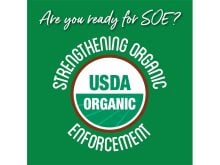Correction – December 22, 2020 – 1700 CST – There are several new 600,000-tonne biodiesel production facilities in the United States planned or under construction (rather than a single facility). Nuseed works in Europe, Southeastern United States, (rather than Southeast Asia) and Australia. Yield potential for carinata could be as high as 60 bushels per acre (rather than guaranteed).
Canola’s close cousin, Brassica carinata, is coming onstream to respond to growing demand for fuels that lower greenhouse gas emissions.
“We have developed carinata as a high value feedstock platform,” Rick Bennett, who leads the carinata breeding program for Nuseed, told Canola Week Dec. 3.
Read Also

U.S. bill could keep out Canadian truckers
The Protecting America’s Roads Act, which was tabled in the U.S. House of Representatives at the beginning of October, would “rid the country of illegal immigrant commercial truck drivers and ineligible foreign nationals.”
He said the world demand and production capacity for biodiesel is rapidly expanding, with several new facilities planned or under construction in the United States – a single one of which alone could add capacity of 600,000 tonnes per year.
“It’s a rapidly evolving and fast-growing industry at the moment.”
While Nuseed’s breeding program is based in Saskatoon, much of the company’s production is based in South America.
Bennet said carinata’s value centres on several production and environmental benefits. First, it’s grown as a winter crop in South America and the southeastern U.S., so it doesn’t displace food production or require clearing of new land. It can help reduce greenhouse gas emissions with minimum till and no till, particularly if it uses organic nitrogen sources such as manure. Carinata is non-GMO, which makes it easier to import into the European Union, specifically France, for its oil and high-protein meal for livestock feed.
All this earns it the stamp of approval from the international Roundtable on Sustainable Biomaterials. This is confirmed by audits of participating farms such as those in Nuseed’s South American program, particularly in Uruguay and Argentina.
It’s also fueling interest and research funding in Canada and internationally, attracting partners such as Mustard 21, the Diverse Field Crops Cluster, Agriculture Canada, the U.S. Department of Agriculture, various universities and industry players.
Brassica carinata, sometimes called Ethiopian mustard, is closely related to canola-quality species such as B. napus and B. rapa. Its agronomics are similar to canola (it also has a big appetite for sulfur, for example), so farmers already have the equipment and know-how to grow it. This is also true on the research side.
“Being a Brassica crop, we’ve benefited greatly from collaborations from the Brassica community,” Bennett said. “Technologies that have been developed for canola or condiment mustards as well as collaborative efforts in these circles have been very beneficial for the program.”
For example, Nuseed is set to release its first hybrids in 2022. Early work in Canada and Chile shows these lines could yield more than 20 percent more than Nuseed’s existing open-pollinated lines. Since carinata is primarily a biofuel feedstock, Nuseed aims to produce 45 percent oil or better, something it has been able to achieve. Figures from the University of Florida show farmers can expect yield potential of 60 bushels per acre.
While South America is the fastest growing area for Nuseed’s carinata efforts, the company is working in Europe, Southeast United States, and Australia to screen varieties for those areas of the world.
Farmers in southern France, for example, plant the crop in mid-June, after winter barley or wheat, then harvest in October or early November. In Australia, Nuseed is working in Queensland and New South Wales to develop carinata for that country.

















